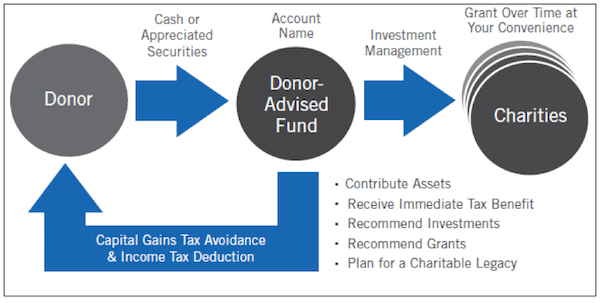Giving to Charity? Learn the Ins and Outs of Donor-Advised Funds
These simple, low-cost vehicles tend to be the most efficient and effective ways to engage in charitable giving.

According to the National Philanthropic Trust, Americans gave $358.38 billion to charities in 2014, a 7.1% uptick from the previous year. And with the deadline for deducting charitable contributions approaching on Dec. 31, now is a good time to give back to an organization and/or support a current relief effort.
While there are multiple vehicles available to help support philanthropic giving, we find that donor-advised funds (DAF) tend to be the most efficient and effective giving vehicles. They are simple, low cost, and flexible. They allow donors to maximize the tax benefits of charitable giving while supporting their favorite organizations.
What is a Donor-Advised Fund?
From just $107.88 $24.99 for Kiplinger Personal Finance
Become a smarter, better informed investor. Subscribe from just $107.88 $24.99, plus get up to 4 Special Issues

Sign up for Kiplinger’s Free Newsletters
Profit and prosper with the best of expert advice on investing, taxes, retirement, personal finance and more - straight to your e-mail.
Profit and prosper with the best of expert advice - straight to your e-mail.
A DAF is simply an account that helps givers manage their charitable contributions. Through an agreement with a DAF provider, a donor creates a specially named account (i.e. “Smith Family Fund”) to which irrevocable contributions are made. The donor receives an immediate tax deduction but is not forced to make any grants. They can work with their adviser to invest and grow the assets and recommend grants to their favorite non-profit, 501(c)(3) organizations at their leisure.

Why Use a Donor-Advised Fund?
Simplicity. Unlike a private foundation, the donor is not responsible for hiring attorneys and accountants or maintaining a board of directors. The sponsoring organization that holds the fund takes responsibility of all the expensive administration work, including filing annual returns and preparing financial statements.
Tax Efficiency. DAF contributions provide a federal income tax deduction up to 50 percent of adjusted gross income for cash contributions and up to 30 percent of adjusted gross income for appreciated securities. Along with publicly traded securities, DAF holders can also contribute complex assets such as real estate, limited partnership interests, private C- and S-Corp stock, and other privately held assets.
Flexibility. DAF holders receive an immediate tax deduction for their contribution but they are not subject to a legal minimum payout requirement like a private foundation. The flexibility helps donors maximize tax benefits while helping them be more systematic and methodical about their giving.
If you haven’t engaged in charitable giving yet, now is a great time to start. And in doing so, consider the benefits of a DAF—to you and to the future recipients.
Taylor Schulte, CFP® is founder and CEO of Define Financial, a San Diego-based fee-only firm. He is passionate about helping clients accumulate wealth and plan for retirement.
Profit and prosper with the best of Kiplinger's advice on investing, taxes, retirement, personal finance and much more. Delivered daily. Enter your email in the box and click Sign Me Up.

Taylor Schulte, CFP®, is founder and CEO of Define Financial, a fee-only wealth management firm in San Diego. In addition, Schulte hosts The Stay Wealthy Retirement Podcast, teaching people how to reduce taxes, invest smarter, and make work optional. He has been recognized as a top 40 Under 40 adviser by InvestmentNews and one of the top 100 most influential advisers by Investopedia.
-
 Stocks Slip to Start Fed Week: Stock Market Today
Stocks Slip to Start Fed Week: Stock Market TodayWhile a rate cut is widely expected this week, uncertainty is building around the Fed's future plans for monetary policy.
-
 December Fed Meeting: Live Updates and Commentary
December Fed Meeting: Live Updates and CommentaryThe December Fed meeting is one of the last key economic events of 2025, with Wall Street closely watching what Chair Powell & Co. will do about interest rates.
-
 This Is Why Investors Shouldn't Romanticize Bitcoin
This Is Why Investors Shouldn't Romanticize BitcoinInvestors should treat bitcoin as the high-risk asset it is. A look at the data indicates a small portfolio allocation for most investors would be the safest.
-
 Why Investors Shouldn't Romanticize Bitcoin, From a Financial Planner
Why Investors Shouldn't Romanticize Bitcoin, From a Financial PlannerInvestors should treat bitcoin as the high-risk asset it is. A look at the data indicates a small portfolio allocation for most investors would be the safest.
-
 I'm a Financial Pro Focused on Federal Benefits: These Are the 2 Questions I Answer a Lot
I'm a Financial Pro Focused on Federal Benefits: These Are the 2 Questions I Answer a LotMany federal employees ask about rolling a TSP into an IRA and parsing options for survivor benefits, both especially critical topics.
-
 Private Credit Can Be a Resilient Income Strategy for a Volatile Market: A Guide for Financial Advisers
Private Credit Can Be a Resilient Income Strategy for a Volatile Market: A Guide for Financial AdvisersAdvisers are increasingly turning to private credit such as asset-based and real estate lending for elevated yields and protection backed by tangible assets.
-
 5 RMD Mistakes That Could Cost You Big-Time: Even Seasoned Retirees Slip Up
5 RMD Mistakes That Could Cost You Big-Time: Even Seasoned Retirees Slip UpThe five biggest RMD mistakes retirees make show that tax-smart retirement planning should start well before you hit the age your first RMD is due.
-
 I'm a Wealth Adviser: My 4 Guiding Principles Could Help You Plan for Retirement Whether You Have $10,000 or $10 Million
I'm a Wealth Adviser: My 4 Guiding Principles Could Help You Plan for Retirement Whether You Have $10,000 or $10 MillionRegardless of your net worth, you deserve a detailed retirement plan backed by a solid understanding of your finances.
-
 A Retirement Triple Play: These 3 Tax Breaks Could Lower Your 2026 Bill
A Retirement Triple Play: These 3 Tax Breaks Could Lower Your 2026 BillGood news for older taxpayers: Standard deductions are higher, there's a temporary 'bonus deduction' for older folks, and income thresholds have been raised.
-
 If You're Retired or Soon-to-Be Retired, You Won't Want to Miss Out on These 3 OBBB Tax Breaks
If You're Retired or Soon-to-Be Retired, You Won't Want to Miss Out on These 3 OBBB Tax BreaksThe OBBB offers some tax advantages that are particularly beneficial for retirees and near-retirees. But they're available for only a limited time.
-
 Waiting for Retirement to Give to Charity? Here Are 3 Reasons to Do It Now, From a Financial Planner
Waiting for Retirement to Give to Charity? Here Are 3 Reasons to Do It Now, From a Financial PlannerYou could wait until retirement, but making charitable giving part of your financial plan now could be far more beneficial for you and the causes you support.